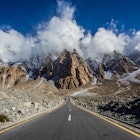
A Trans-Mongolian adventure: riding the rails from Moscow to Beijing
Oct 5, 2017 • 6 min read

Lake Baikal is one of the most popular destinations along the Trans-Mongolian route © Katvic / Shutterstock
Click-clacking along the tracks for thousands of kilometres, getting a glimpse into some of the most intriguing places on earth – it’s easy to understand why the Trans-Siberian Railway is right up there as one of the world’s most dreamed about train rides. There are several routes to choose from when deciding on your itinerary, but the Trans-Mongolian is arguably the standout one.

Crossing three vast countries, each as fascinating as the next, the train trundles through the seemingly endless birch forests of Russia, skirting impressive Lake Baikal and the wilds of the Siberian taiga, into an entirely different world of steppes dotted with gers (traditional yurts) and the stark Gobi Desert in Mongolia, before nature makes way for the urban landscape and skyscrapers of Beijing.
You can make this epic journey in either direction, starting or ending in Moscow or Beijing. Here we outline the route starting from Moscow. The train follows the Trans-Siberian Railway until Ulan-Ude, where it splits off and takes the Trans-Mongolian route. All up, the journey from Moscow to Beijing takes six nights and five days, spanning 7826km. While you can do the trip direct, don’t miss the opportunity to visit Mongolia. If you plan to do stopovers, this has to be pre-arranged and tickets organised accordingly.

Moscow to Ulaanbaatar
This part is the crux of the journey. Starting from Moscow’s Yaroslavsky station, you travel through Russia for five nights and four days before arriving in Ulaanbaatar, Mongolia’s capital. If time is on your side, there are plenty of towns to break the journey. If you opt for a direct trip, you’ll only see the stations as you stop for usually 15 to 30 minutes – enough time to restock on water and instant noodles or local snacks on the platform, take some photos, stretch your legs and hop back on.
For the most part, you’ll be staring at vast birch forests (which has quite a meditative effect when coupled with the swaying train), drinking lots of tea or vodka, reading, playing cards, and chatting to other travellers and locals on the train. The final day brings a well-deserved change of scenery – just as you start to get a bit delirious from endless rows of the spindly trees, you’ll be twisting your neck from left to right to see mountains on one side of the train and the glistening Lake Baikal on the other. And the next landscape change, on arrival in Mongolia, is nothing short of surreal.

Day 1
The train departs at 11:55pm from Moscow. If this is your first sleeper train, you might get little shut-eye the first night as your body is jerked around a bit (it takes some time getting used to). If you wake bleary-eyed from a restless night, don’t stress – you have nothing to do but sit back and stare at the forests of Russia whirring past, remembering how to pass the time without the internet. There are a few station stops throughout the day; you can stretch your legs for 15 to 20 minutes at each one.
Day 2
More birch trees roll past as you start to settle into the rhythm of train life. In the afternoon, the train stops in the Siberian town of Omsk, known as the place where Dostoevsky was exiled back in 1849. You’ll have roughly 20 minutes, so you can hop off and take a look at the Lenin statue in front of the station.

Day 3
Time zones start to get a bit disorienting. The main stop is at Irkutsk early in the morning (local time) for 45 minutes, while people hop on and off. Irkutsk is a great base for visiting Lake Baikal, 70km southeast of the town, and it’s the most popular Siberian stop on the journey, not only for its proximity to the lake but also for its historical architecture, museums and churches.
Day 4
Say goodbye to those birch trees: day four offers the best scenery of the entire trip when Lake Baikal, the largest freshwater lake in the world, comes into view on one side and mountains on the other. The train twists around some tight turns near the lake and skirts the edge just metres away, so you can take some great photos.

Next, get ready for your first border crossing. The train stops at Ulan-Ude for about 45 minutes, then later in the day crosses the border at Naushiki. There are some scary stories about Russian officials and border crossings on the Trans-Mongolian, but generally it should be quite straightforward with professional and efficient staff. (Note that the toilets will be closed during the crossing, which can last for hours.) The Russian dining car is changed over for the Mongolian one, which is quite impressive with its wooden carving features.
Day 5
Wake bright and early and pull up your cabin blind to witness a dramatic change in scenery as you get your first look at Mongolia – rolling hills, wild horses dashing along with the train and nomad gers spread out along the open steppe. The train stops at Ulaanbaatar early in the morning for 45 minutes. This is one stopover you don't want to miss. Spend a couple of days in the capital checking out some of the museums and taking a break from cup noodles and Russian bliny (pancakes) to enjoy Buddhist vegetarian cuisine or feast on khorkhog (Mongolian lamb cooked on hot stones). If you have more time, get out into the countryside, staying in gers, interacting with locals, trying out yak milk and horse trekking for days.

Ulaanbaatar to Beijing
The train departs Ulaanbaatar early in the morning and reaches Beijing mid-morning the next day. This is the final leg of the trip and you’ll no doubt start to feel both anxious to get off and melancholy that it’s about to end. Crossing from Mongolia into China is no fun, unless you’re a train-mechanics fan. Mongolian and Chinese railroads have different track gauges, so all the bogies must be changed in a painstaking process that takes hours late at night and requires passengers to stay on the train. You may be allowed to get off once your passports have been checked, and you can grab some food near the station – if you’re still awake! The Mongolian dining car is also replaced with the Chinese one, and you’re served a set Chinese breakfast in the morning before alighting the train.

This leg of the journey crosses the Gobi Desert, and you’ll get a brief insight into this harsh environment. As you cross into China, there’s another surprise shift in the scenery as huge gorges come into sight. Then, before you know it, you’re whizzing past packed station platforms, endless apartment buildings and into the frenetic pace of Beijing, feeling fortunate to have experienced this once-in-a-lifetime journey.
Make it happen
Planning the Trans-Mongolian trip as an independent traveller is a bit of a logistical nightmare, but it can definitely be done with some good organisation. Otherwise you can use an agency to do it for you, such as Real Russia who are highly recommended and provide excellent support. For more practical tips, see our feature How to pack for the Trans-Siberian Railway.
Explore related stories



 Public TransportThe ultimate guide to Thailand’s Mae Hong Son loop on a motorbike
Public TransportThe ultimate guide to Thailand’s Mae Hong Son loop on a motorbikeDec 28, 2021 • 11 min read
 Wildlife & NatureJoining the bikers of Gilgit-Baltistan: exploring Northern Pakistan by motorcycle
Wildlife & NatureJoining the bikers of Gilgit-Baltistan: exploring Northern Pakistan by motorcycleDec 17, 2019 • 6 min read




 Road TripsThe Siberian welcome: the best guides along the world’s longest train journey
Road TripsThe Siberian welcome: the best guides along the world’s longest train journeyMar 14, 2018 • 5 min read
